Review of the AliExpress IoCrest USB4-to-10GbE Adapter
Why is a USB 10GbE network adapter such a big deal? USB NICs have been around for literally decades, so a new network adapter that takes advantage of USB can’t be that exciting, right? Well, if you’ve been in the market to buy a network upgrade for more modest and streamlined systems that lack PCIe slot expandability, then chances are you have noticed the severe lack of USB options in the market. Although a number of domestic-level systems for home and business have started rolling out with greater than gigabit network connectivity, when it comes to expanding older generation devices (or even scaling up relatively modern devices to take advantage of greater network speeds), the range of solutions on the market is actually pretty limited. A few years ago, this was alleviated slightly by the rollout of Thunderbolt to 10G adapters arriving in the market, but because of Intel’s restrictive use of Thunderbolt certification and numerous hurdles in adding Thunderbolt to the majority of devices, these are pretty expensive adapters and also have zero backwards compatibility. Fast forward to now, and thanks to the more open-ended compatibility that USB4 features (supporting USB and Thunderbolt 3/4), the idea of a 10GbE USB-connected network adapter has become a reality.
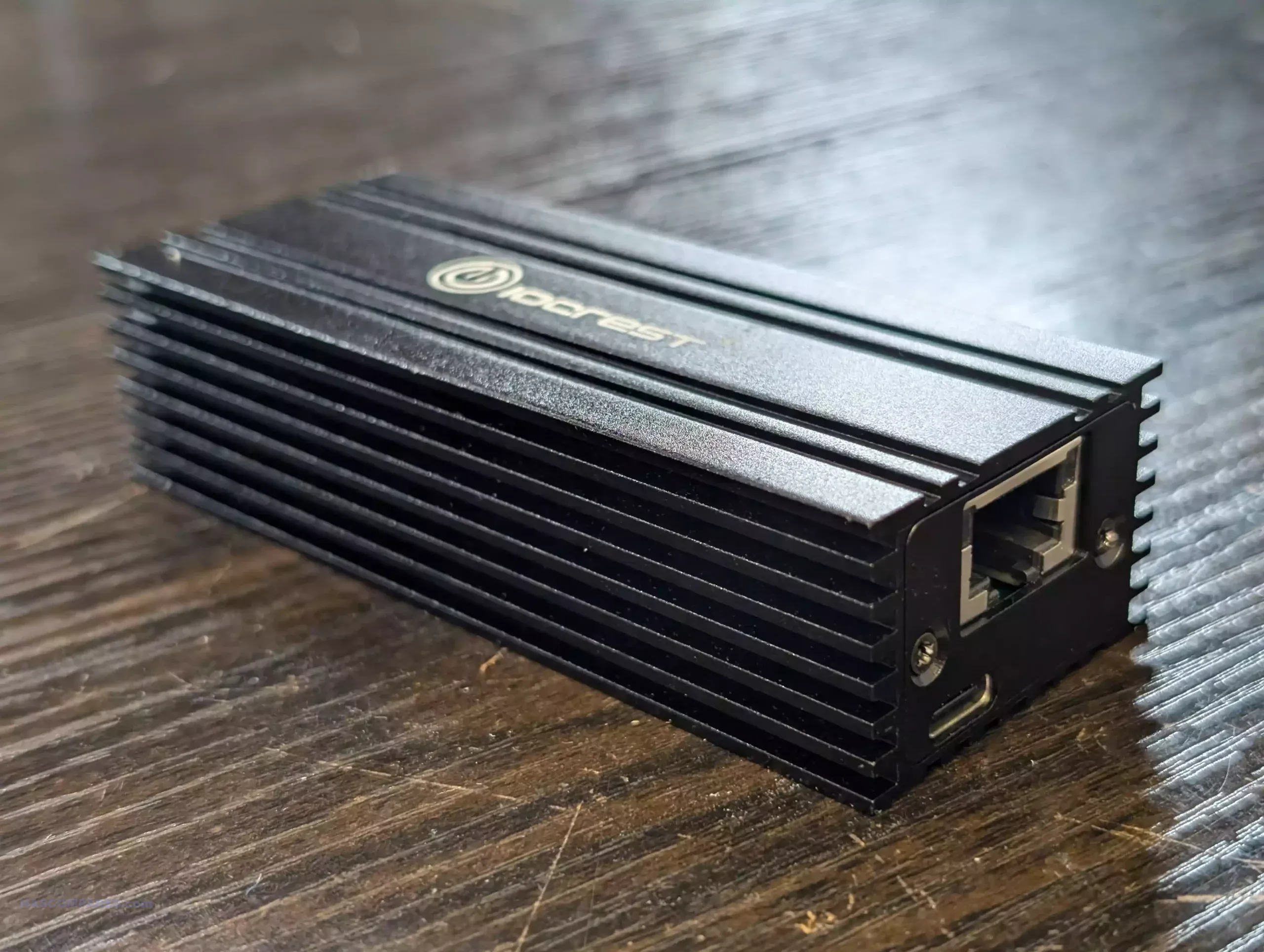
So, the new IO crest USB4-10G adapter is now available. Although I’m sure we will see rebranded versions of this flooding the market relatively soon, alongside established players like QNAP and Sonnet rolling out their alternatives, let’s take a deep dive into the device and find out whether it deserves to be your next network upgrade purchase.
Buying the Adapter: A Quick Note !!!
The adapter is currently available from several different retailers, but is more widely available at the time of writing on AliExpress. Pricing on this adapter will fluctuate rapidly, and I have seen it retailed for as little as $82 all the way up to $140. For this review, I purchased a unit at £72 without tax. It arrived in under 8 days, and although the packaging is phenomenally bare-bones, I can vouch for the fact it arrived intact. Below are a few suggested links to retailers selling the USB4 to 10GbE adapter that you may find useful. Using these links will result in a small commission fee to NAScompares, which helps us keep doing what we do.
| Where to Buy?
|
Given the similarities between this adapter and the Thunderbolt 3 to 10GbE alternatives in the market, this IO crest device takes a slightly different approach in its hardware. Arriving in a much chunkier surrounding heatsink, this device has the network connection and the USB input on the same side.
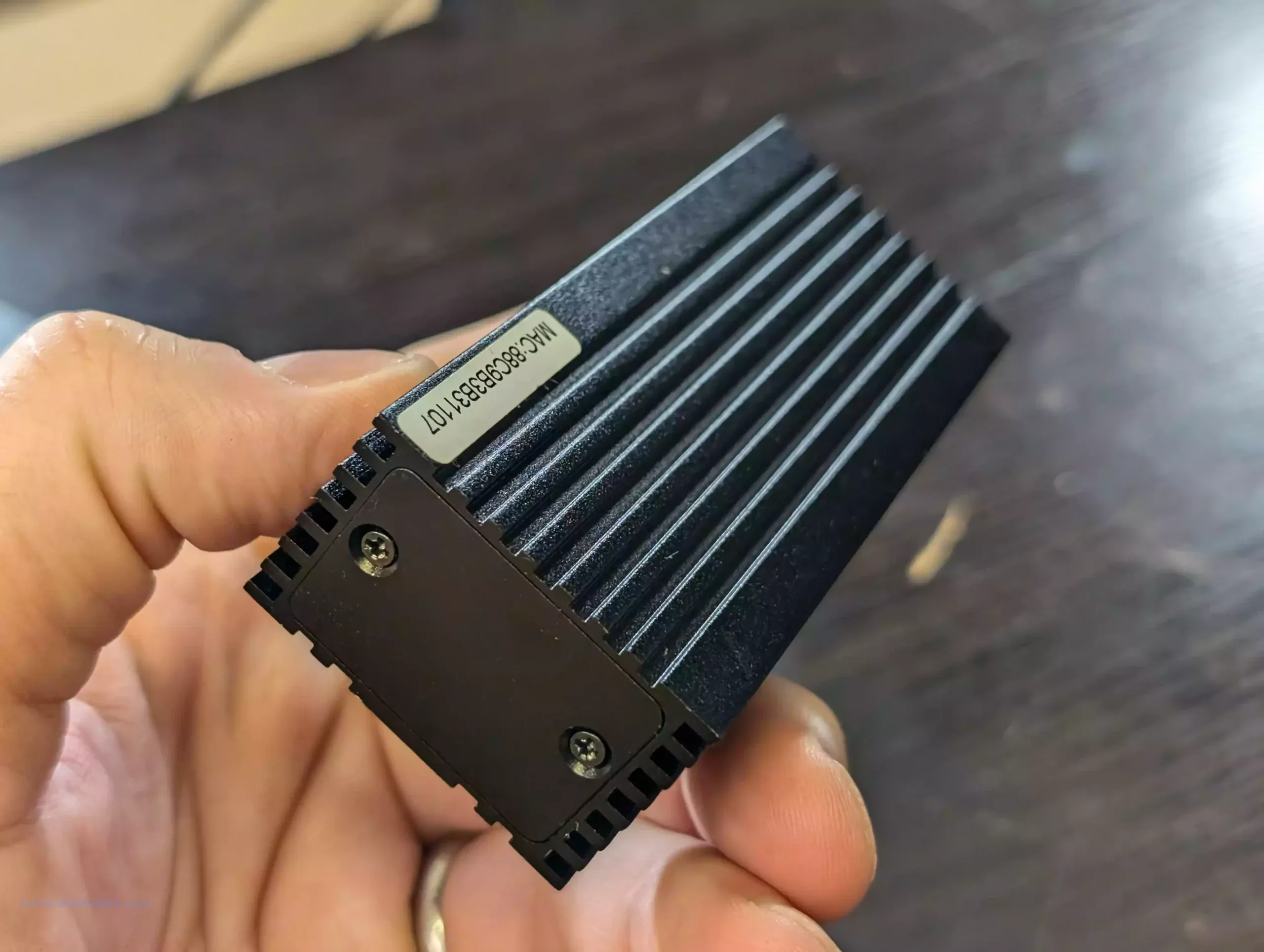
Despite the large look of the thing and its firm metal exterior, it is surprisingly light. It’s really the size more than anything that might bother some users.
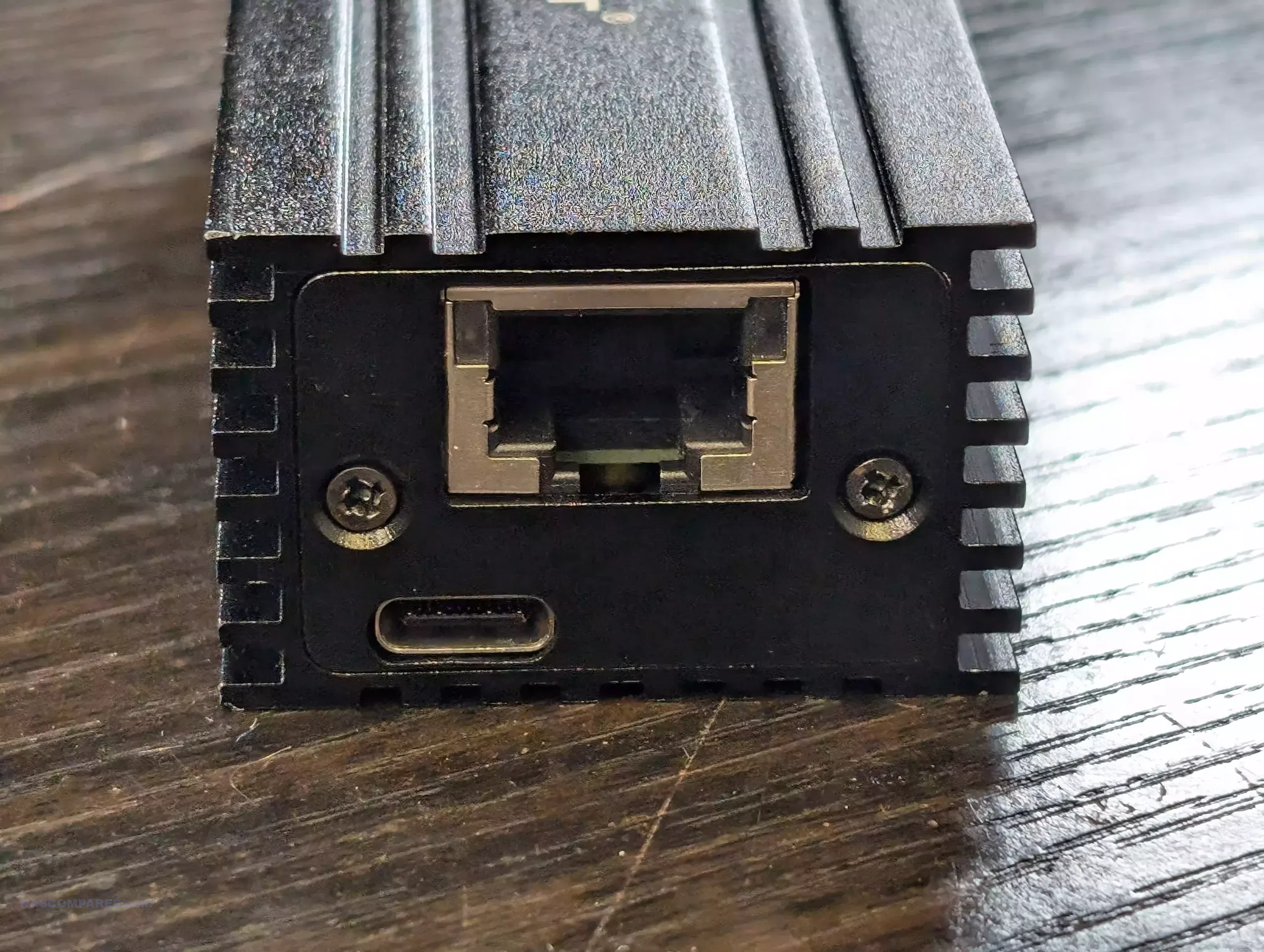
Currently, the device is only available in copper/10GBASE-T hardware configurations, but almost certainly we’re going to see SFP/fiber versions of this adapter in due course. The copper 10G connection supports auto-negotiation, so you will still be able to take advantage of lesser 5G/2.5G/1G connections when utilizing this adapter.
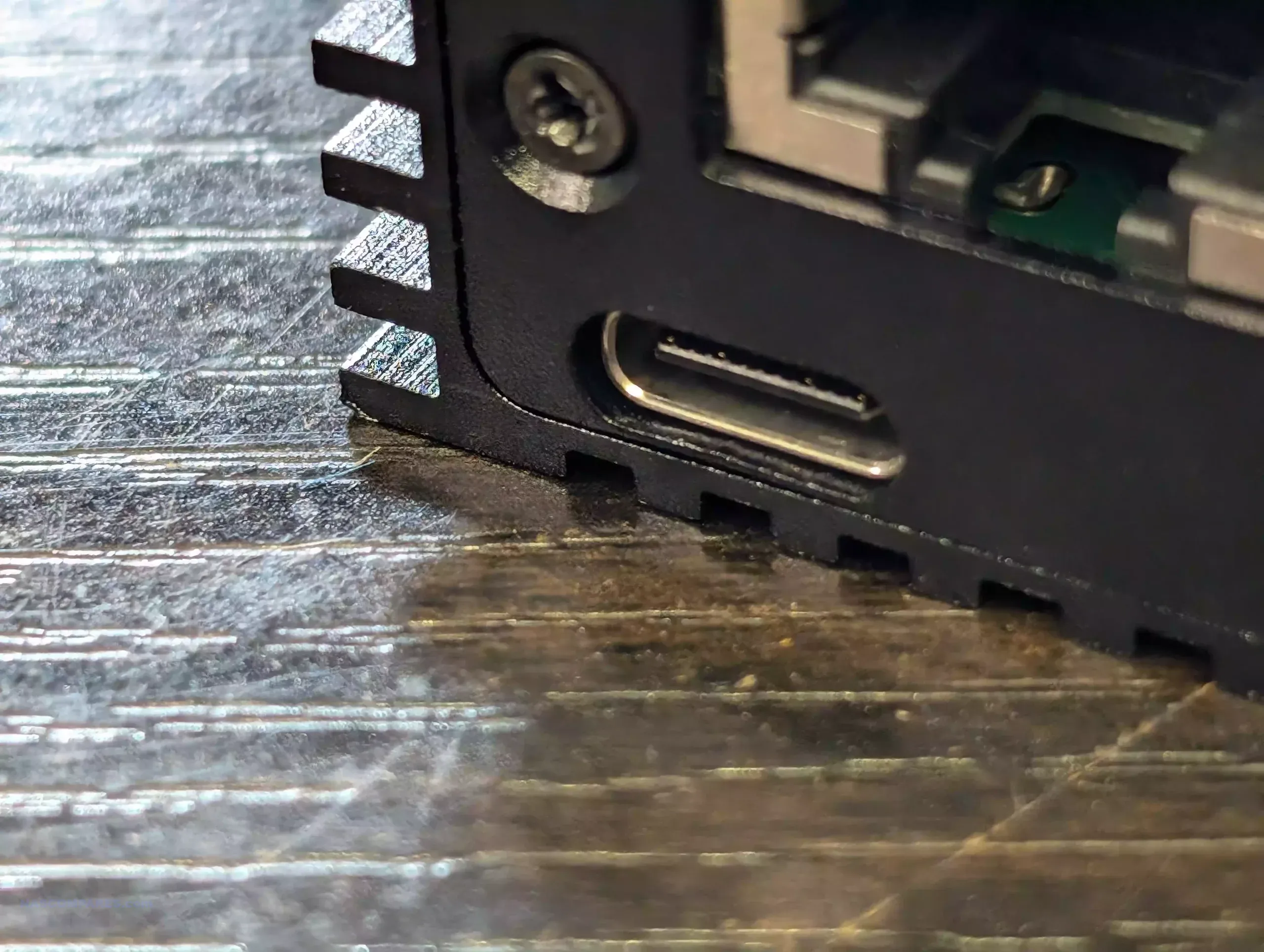
The USB Type-C port, however, is a mixture of good and bad news. On the one hand, USB Type-C on this adapter allows for power delivery, meaning that adding this 10G connection does not require any additional power input to establish a connection with a 10GbE network. Additionally, you can utilize this adapter on a modern USB4 system, as well as on a Thunderbolt 3 or Thunderbolt 4 system too.
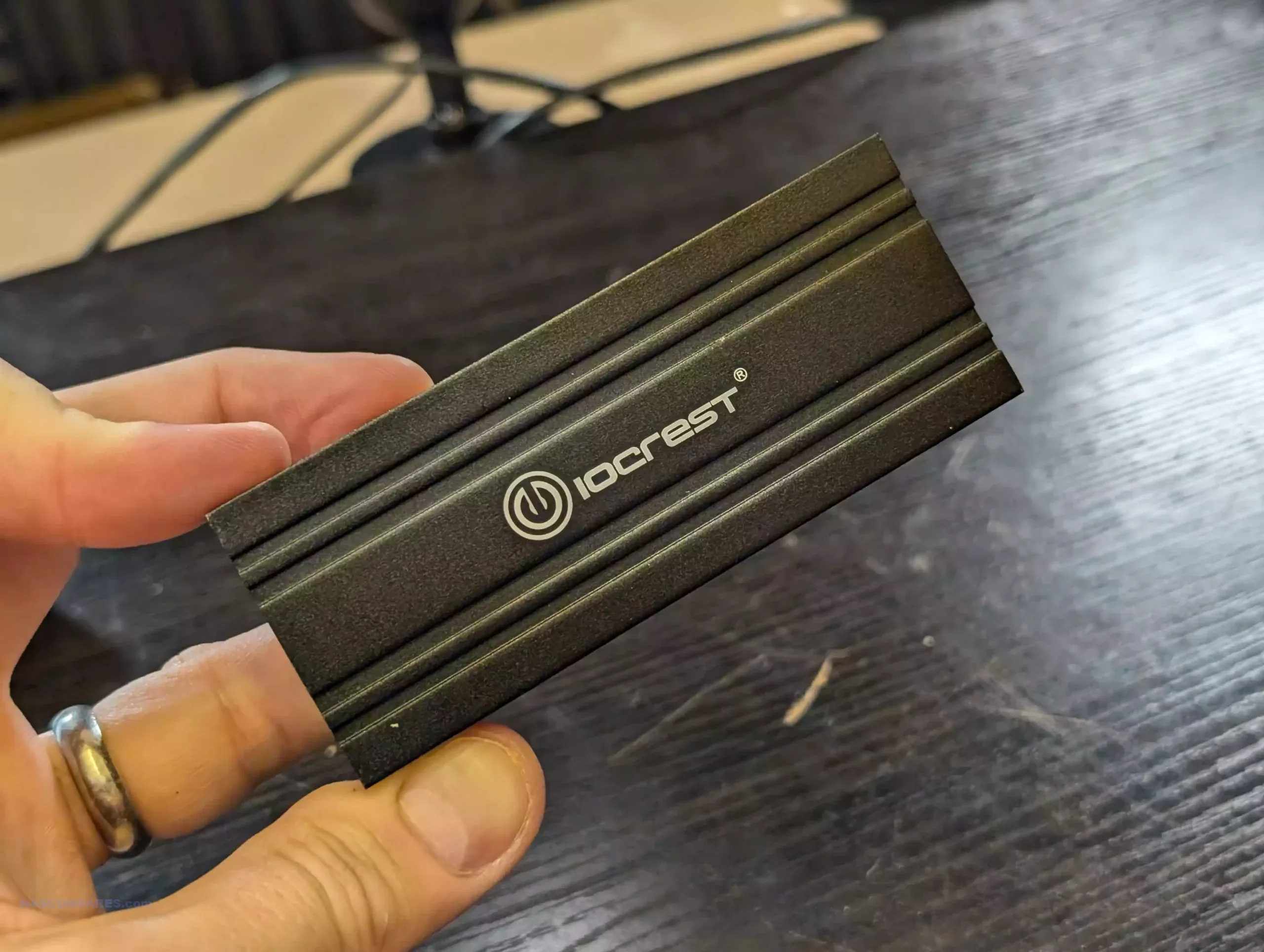
Given the big price difference between this USB4 10G adapter and established Thunderbolt-specific adapters from ATO, Sonnet, and QNAP costing much more, this allows for a greater degree of flexibility and affordability versus those Thunderbolt options. A big part of this is down to the increased compatibility that USB4 brings and a much easier threshold of integration compared with previous generation Thunderbolt client devices.
| Specification | Details |
|---|---|
| Model | IOcrest USB4 to 10GbE Ethernet Network Adapter |
| Compatibility | USB4, Thunderbolt 3/4, Windows, Linux, Mac OS |
| Interface | USB-C (Thunderbolt 3) |
| Ethernet Port | 10Gb/s, 5Gb/s, 2.5Gb/s, 1Gb/s, 100Mb/s Base-T |
| Power | Bus powered |
| Jumbo Frame Support | Up to 16 KB |
| Operating Power per Port | 2.5W (10GBASE-T), 1.5W (5GBASE-T), 1W (1GBASE-T) |
| Advanced Features | AVB, PTP/1588v2, Sync-E, MSI, MSI-X, INTx, NC-SI |
| Protocols Supported | MCTP, IEEE 802.3an/bz/ab/u/q/x/az |
| Temperature Range (Operation) | 0°C to +108°C |
| Temperature Range (Storage) | -40°C to +110°C |
| Chipset ID | AQC113 |
| Number of Ports | 1 Port |
| Transfer Rate | 10000Mbps |
| Dimensions | 102.7mm x 40.4mm x 25.6mm |
| OS Compatibility | Windows 10/11, Linux Kernel 3.10 and later, Mac OS |
| Additional Notes | Does not support Type-C, USB 3.0/3.1/3.2 interfaces |
However, the bad news is that despite it being a USB4 adapter, it does not support the usual backwards compatibility of the USB4 port on your laptop, NAS, or desktop computer. In essence, this means that you cannot utilize this device with a USB 2, USB 3, USB 3.1, or USB 3.2 port. This is going to be quite a blow for users who were looking forward to a USB to 10G adapter for older legacy hardware that does not accommodate PCIe upgrades. A big part of the logic behind this is USB4 supporting Gen4 architecture and the extra bandwidth and negotiation that it brings, but it’s still going to be a bitter pill for users who have been waiting for a USB-convenient option to scale up to 10GbE networks. This is made especially galling when you know that USB 3.2 Gen 2 gives 1,000 MB per second and USB 3.2 Gen 2×2 provides 2,000 MB per second, yet neither of these options can be used with this 10G/1000 MB adapter.
(See Video Below to Learn More – or visit the article on the QNAP USB4-to-10GbE Adapter HERE)
This device does not represent the end of the road for this kind of adapter, though. At Computex 2024, QNAP demoed the first of a large range of USB4 to network adapters that they plan to introduce in the next 6 to 8 months. These began with a USB4 to 10GbE copper and SFP adapter but plan on scoping out towards dual 10GbE adapters and even 25GbE adapters too. Needless to say, these will be considerably more expensive and no doubt are going to require a great deal of tooling before they hit retail, but at least we know that this is not going to be the only adapter in the market for USB users.

Opening up the adapter, by removing two screws at either end of the casing, reveals that the internals do not have any kind of active fan. This means that there will be no noise during operation and cooling internally is managed via passive dissipation through strategically placed internal heat sinks into the surrounding casing.
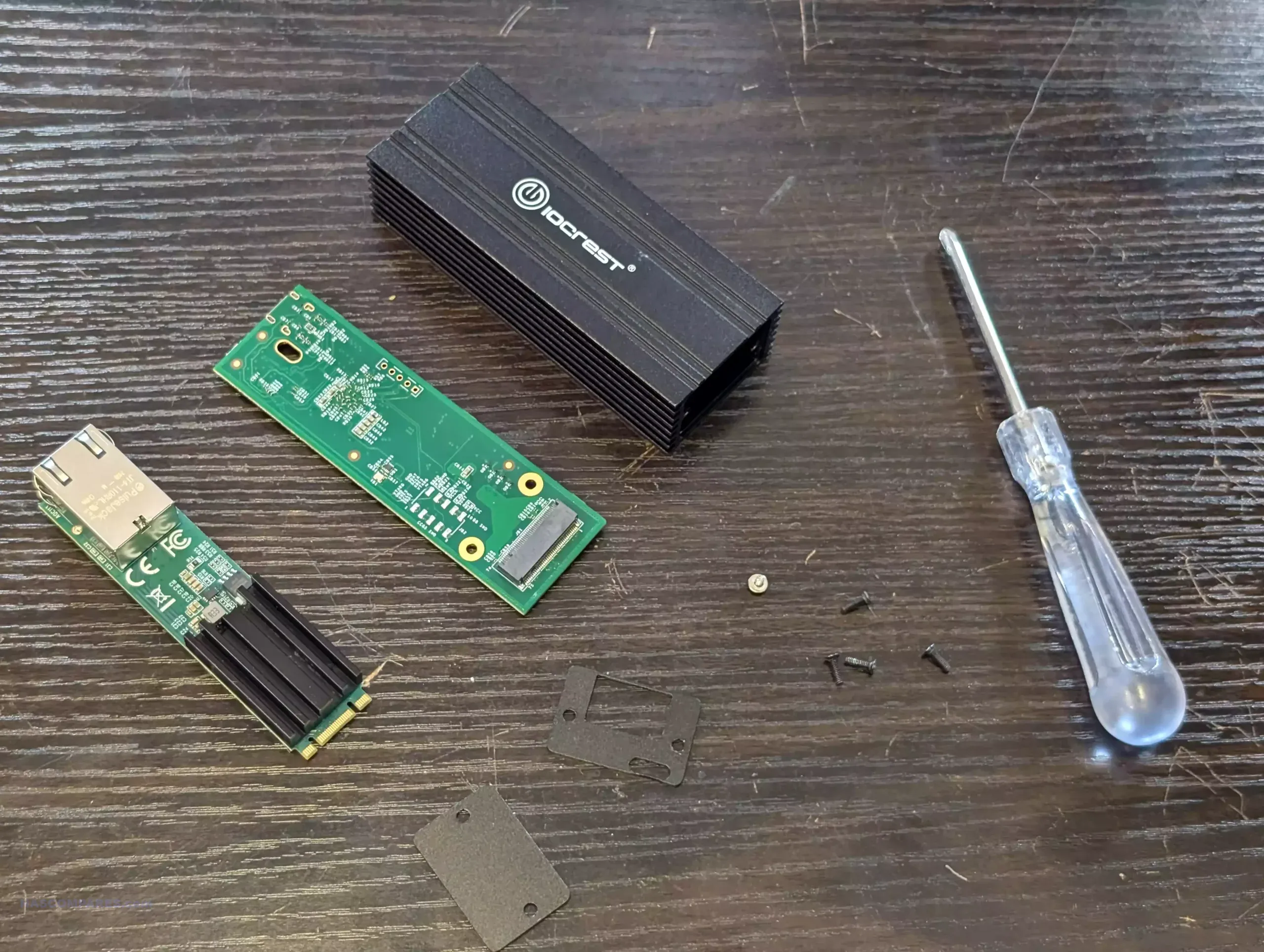
Indeed, the inside of the USB4 10G adapter only comprises two core pieces: a main M.2 mounting board that connects to the USB4 port, and a separate M.2 PCB that has the 10G copper connection mounted.
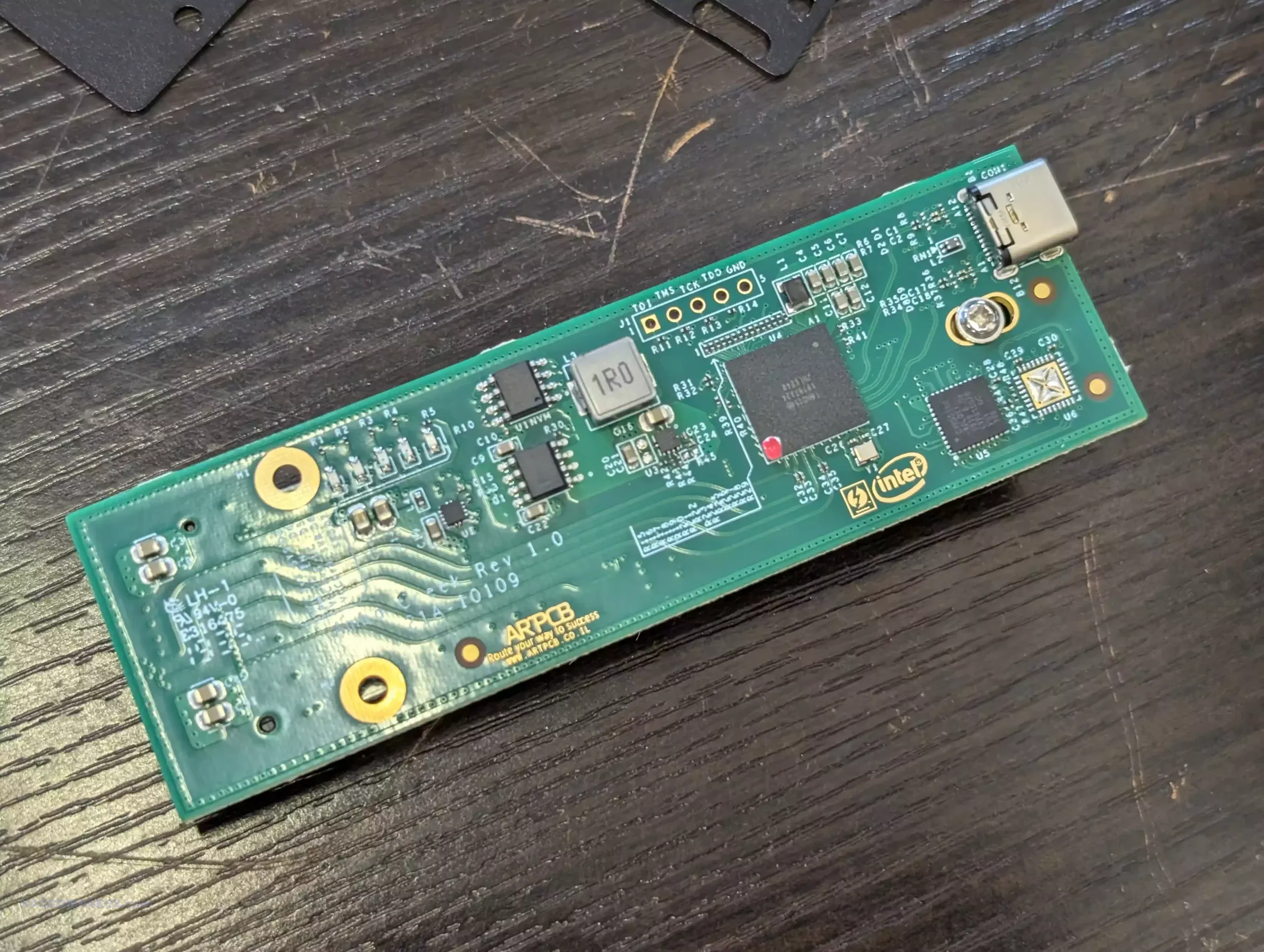
The main Aquantia controller that requires the AQC113 driver to be used is placed under a full-width black heatsink. This heatsink has thermal paste but also additional adhesive to keep it firmly in place to connect with the external casing. This means that removing that black heatsink will likely damage the adapter, so we have decided to hold off on going for a deeper dive into the internals for now until we’ve completed our testing.
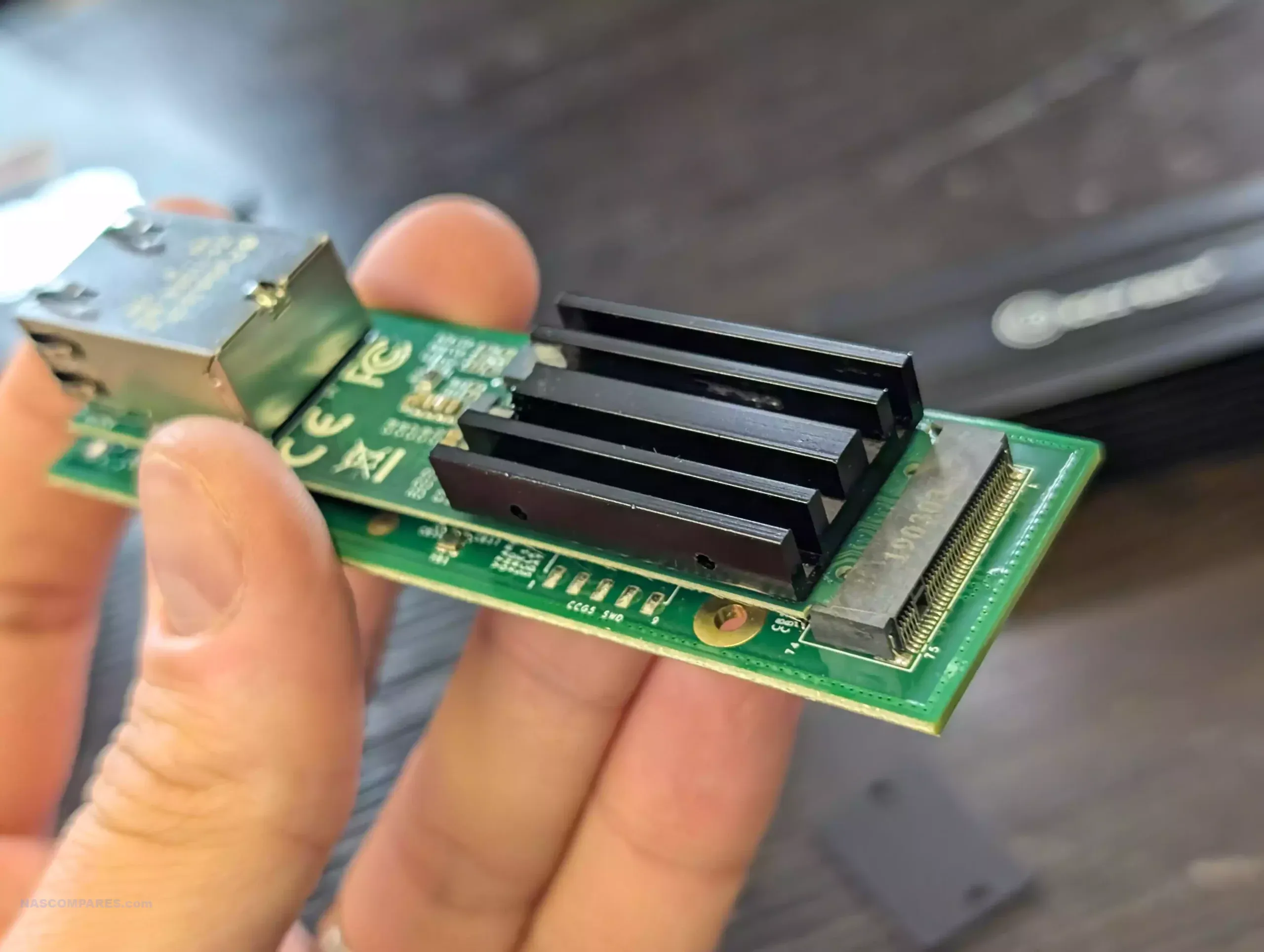
Putting the device back together, we decided to conduct multiple tests with a 10G NAS system and a Windows 10 NVMe-based laptop with USB4 connectivity to see what output we could get.
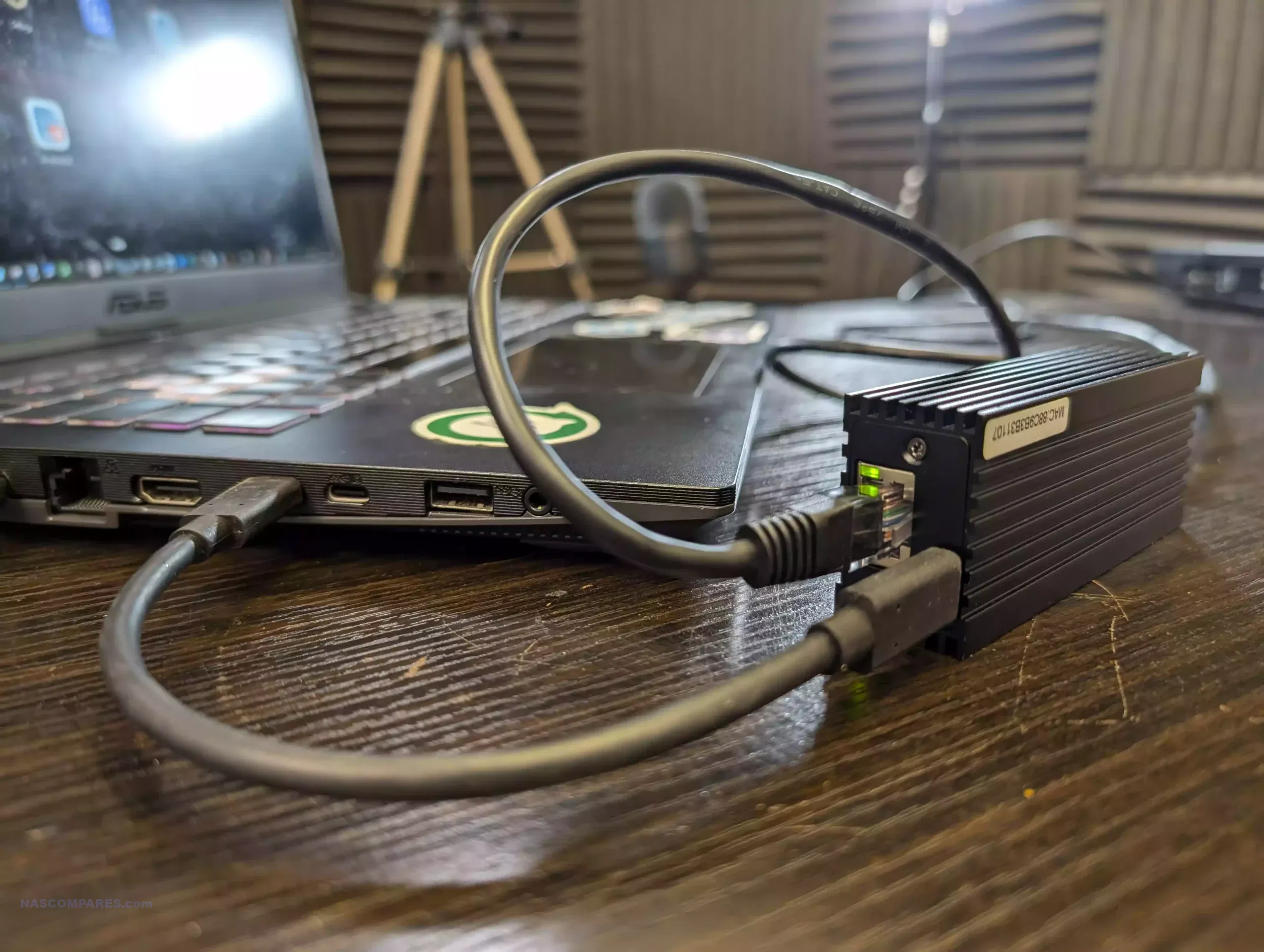
We set the NAS up (an Asustor Flashstor 12 Pro with 10GbE and 4x Gen 3 SSDs in RAID 5) directly connected to the adapter, which was then connected to the Windows PC. We mounted an SMB share as a mapped drive, set jumbo frames to 9k on both devices, and began some fairly rudimentary file transfers.
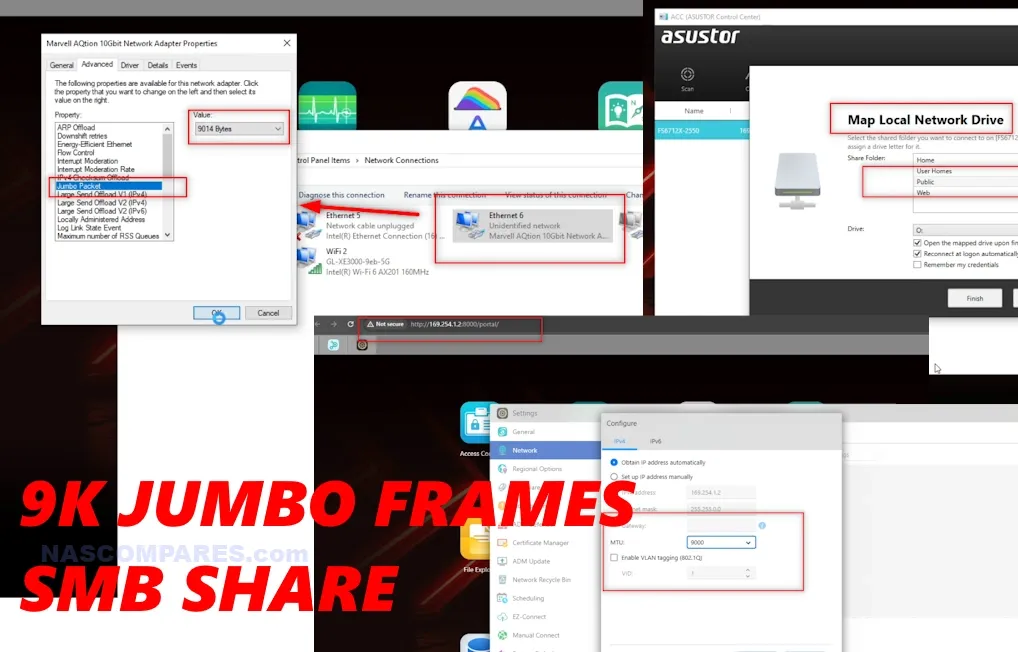
We did a 256MB ATO disk benchmark transfer and we saw the full saturation of 10GbE quickly and easily.

We then performed an AJA disk benchmark test of a 1GB 1080p config, and performance was middling between 600MB and 800MB up and down.
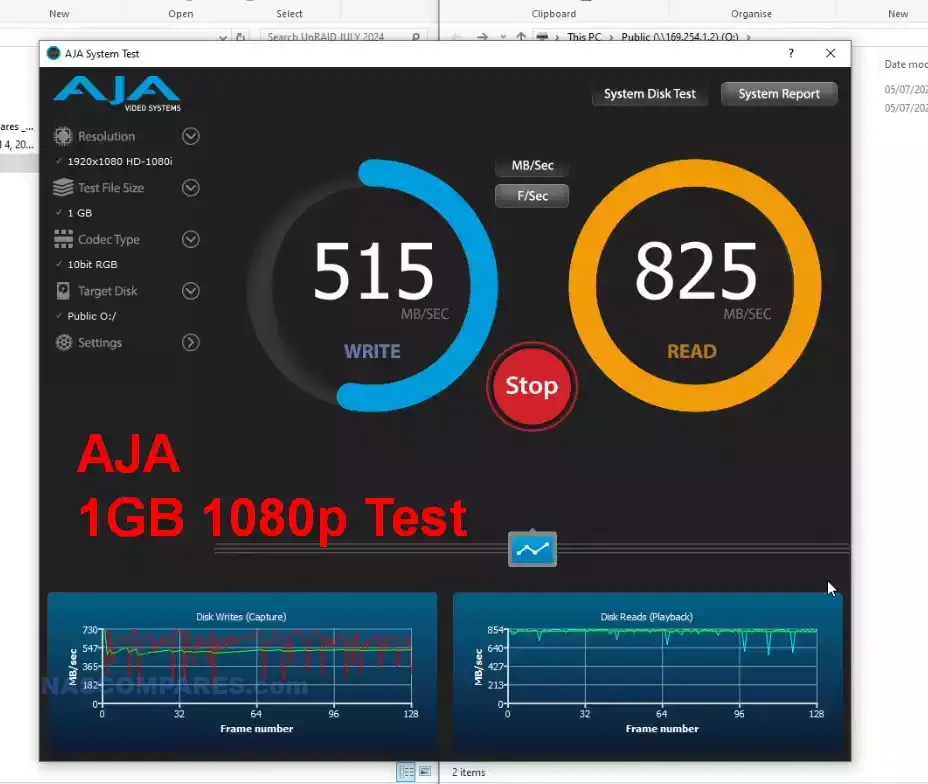
We then performed three separate Windows transfer tests. The first was a single 10GB 4K media file which transferred over at a seemingly capped 600MB per second. It was unclear whether this was caused by the host machine, the Celeron-powered NAS, or the device itself. But given that we’d already observed greater performance in other synthetic tests, this was quite unusual.
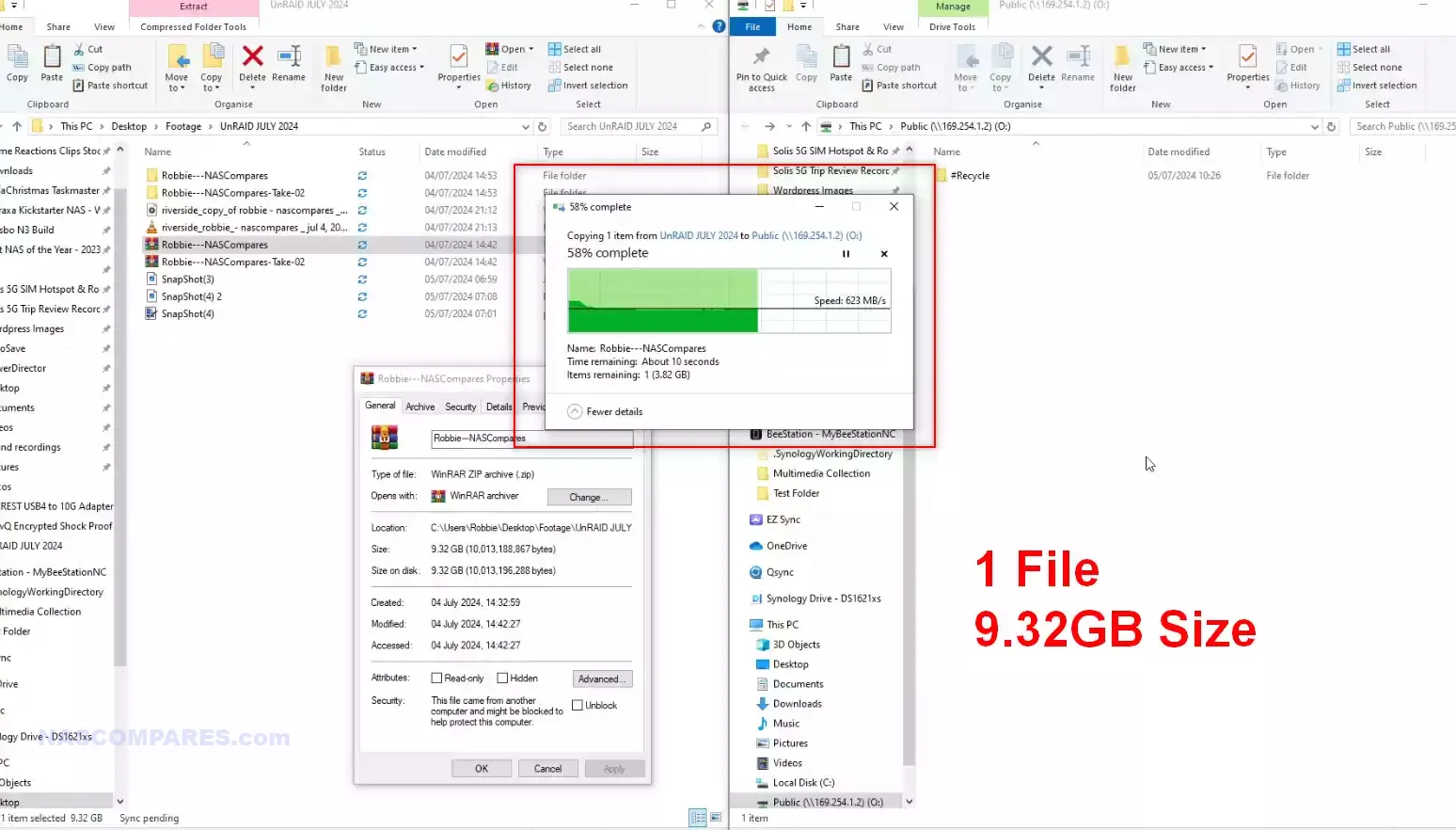
Then we transferred 1,000 PNG files that amounted to just 1GB of data and performance was pretty mediocre, rarely going above 50MB per second. This huge IO factor of so many transfers per second being managed was still fairly mediocre, and I’ve seen performance numbers of 300 to 500MB per second using comparable Thunderbolt 10G adapters by comparison.
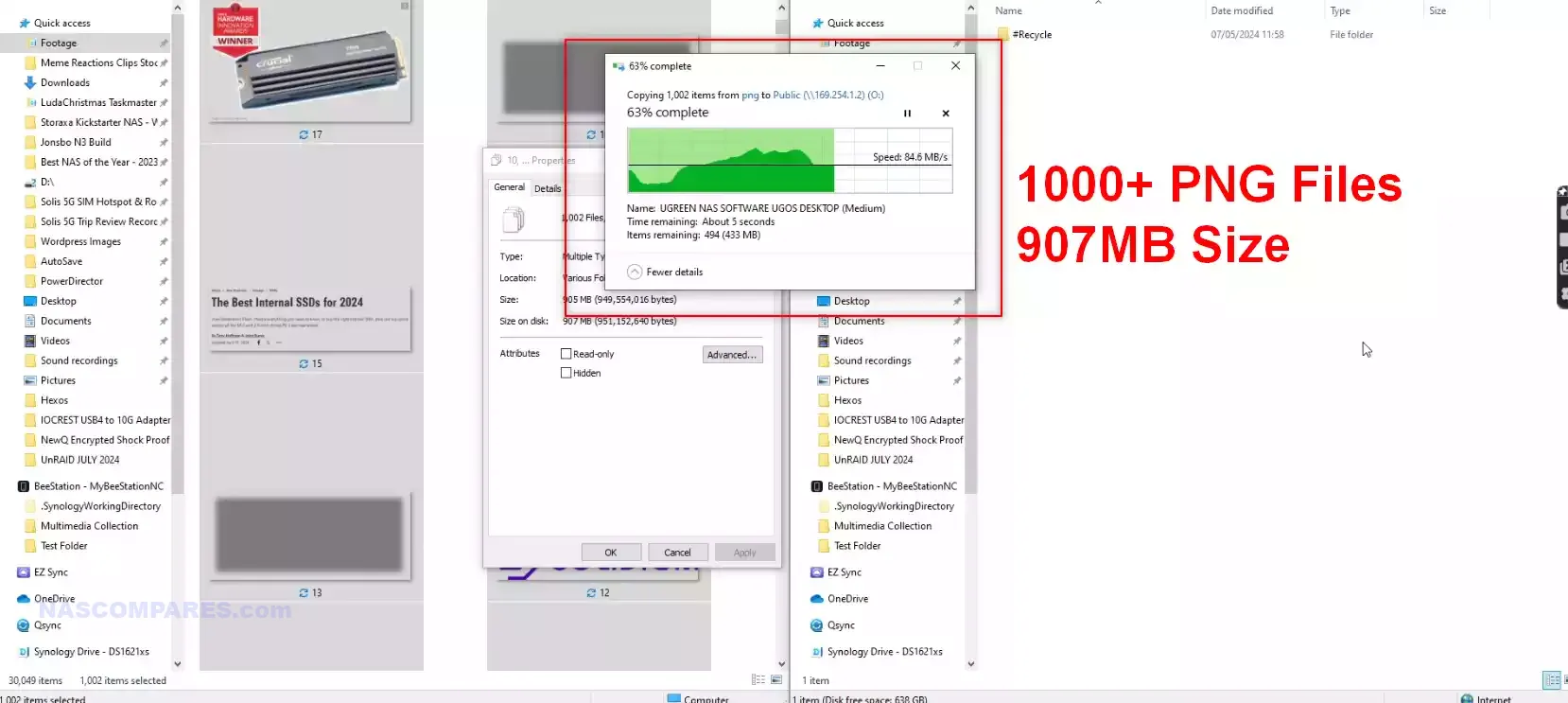
Finally, I transferred over 10GB of a little over 33 high-end multimedia files and we saw performance numbers of around 500 to 600MB per second maximum. Once again we saw that unusual cap for Windows transfer of around 600MB per second with that higher-end multimedia, which did indicate oversaturation was present here, or at the very least poor PCIe routing internally.
UPDATE – During my testing and rushing, I didn’t notice the BLOODY OBVIOUS fact that the m.2 that supported the 10GbE connector is attached to SATA M.2 connector! Therefore there is clearly going to be a limitation down to 6Gb/s. This still doesn;t quite explain how the ATTO test hit full saturation at 256MB (an SMB mapped drive without caching), but this does make the results alot clearer Thank you to YouTube user @sl1ckk1ll3r and his comment here.
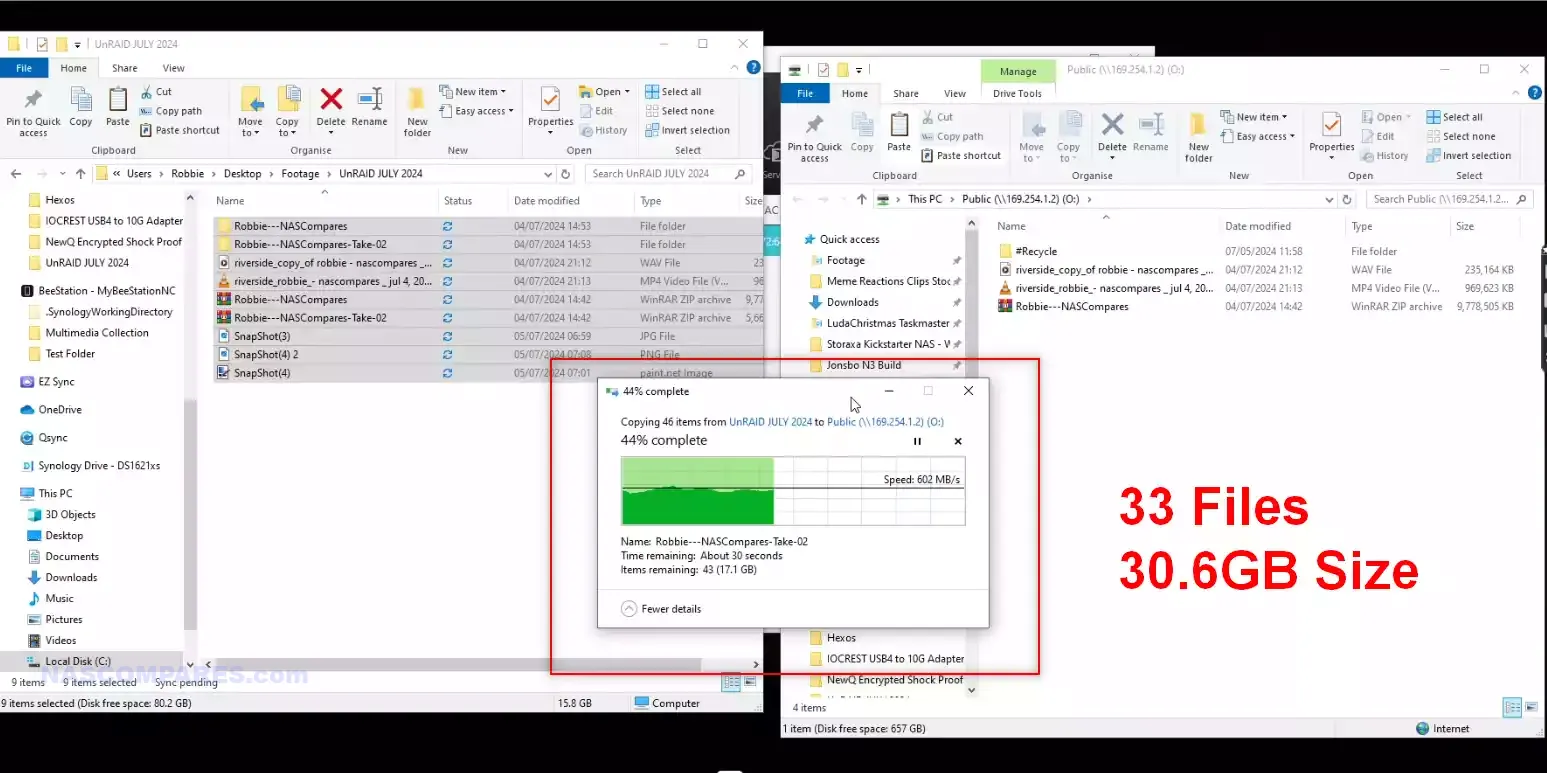
We will be testing several different NAS systems in the coming weeks and creating a separate article bench testing a lot more performance numbers for different NAS systems, as well as highlighting how many systems actually support this adapter to increase network connectivity on modest NAS systems soon. At the time of writing, I’m not going to say the performance is bad, but I am going to say that this does seem lower in performance compared with Thunderbolt to 10G adapters released a couple of years ago.

IOCREST USB4-to-10GbE Adapter Review Conclusion

As an alternative to a PCIe upgrade on your system, I think it’s unquestionable that this is a much more convenient option for most users. Equally, this is considerably more affordable than dedicated Thunderbolt alternatives in the market that are forced to have increased price points due to Intel certification and licensing, as well as being in the market a little while longer with stock sitting on shelves. However, this is definitely the first of a new wave of network adapters that are going to allow users greater degrees of flexibility to scale up the network connectivity of their systems. The fact that you cannot take advantage of backwards compatibility with older legacy USB connections is definitely going to hurt older generation servers and client hardware, but in the grand scheme of things, I think I am a little bit more excited about the idea that this kind of technology is going to allow affordable and accessible means for dual 10GbE connectivity and even 25GbE in the future. I can definitely recommend this adapter, but just keep your expectations on performance in check. Also, do not be fooled into thinking you can use this on older generation hardware. USB4 may well support Thunderbolt connectivity, but the backwards compatibility that USB4 promises is not present in this adapter.
| Where to Buy?
|
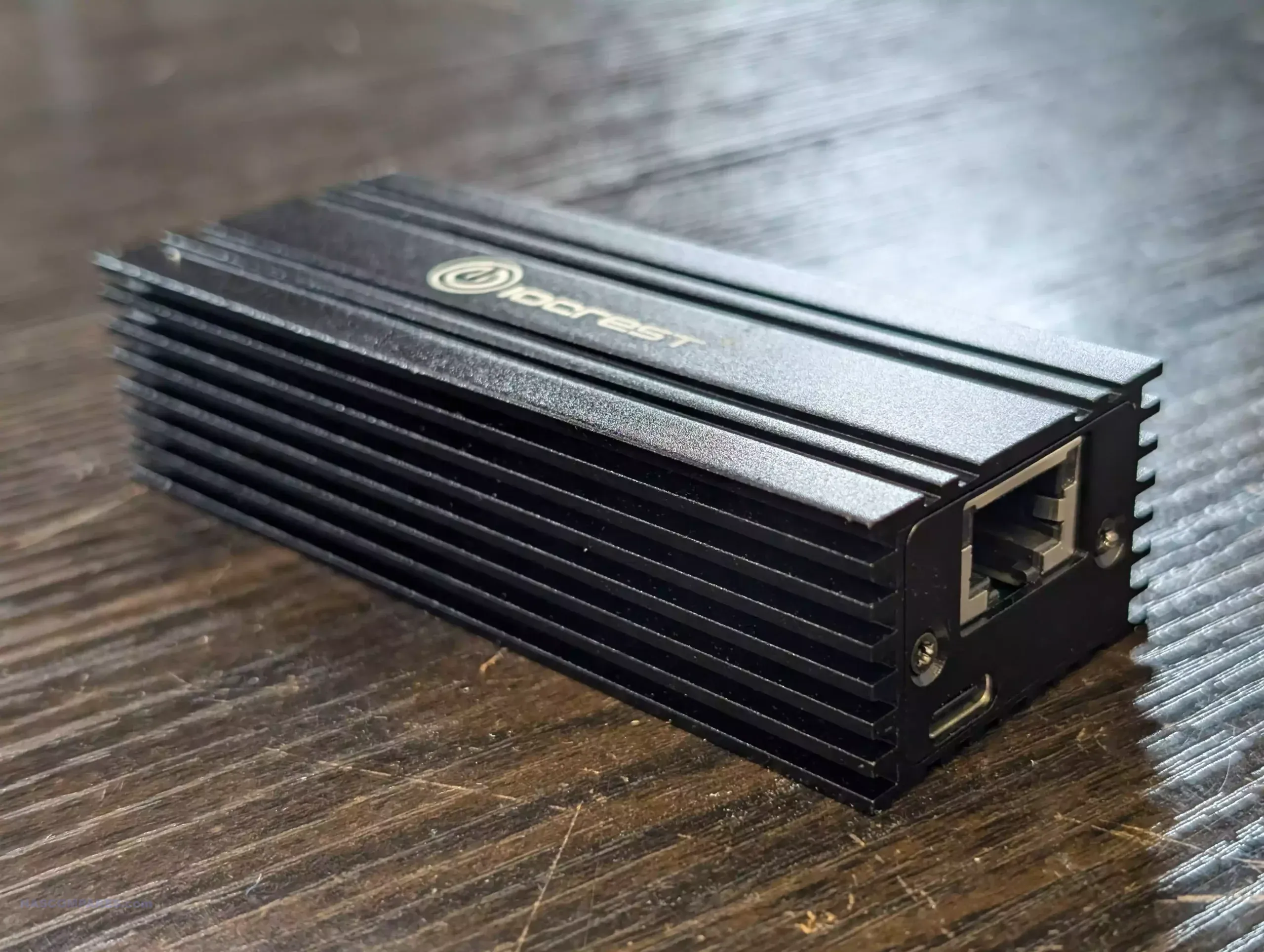 |
|
| PROS of the IOCREST USB4-to-10G NIC
Cheaper than a Thunderbolt NIC Alternative Similar Pricing to 10GbE PCIe Adapters BUS Powered and USB-C Thunderbolt 3 & 4 Support Low Power Use (1W to 2.5w Max) Opens the door to 2x10G and 25GbE |
CONS of the IOCREST USB4-to-10GbE NIC
No Support for USB 3.1 and USB 3.2 Deployment Only currently on AliExpress Currently Performance is mixed |
🔒 Join Inner Circle
Get an alert every time something gets added to this specific article!
This description contains links to Amazon. These links will take you to some of the products mentioned in today's content. As an Amazon Associate, I earn from qualifying purchases. Visit the NASCompares Deal Finder to find the best place to buy this device in your region, based on Service, Support and Reputation - Just Search for your NAS Drive in the Box Below
Need Advice on Data Storage from an Expert?
Finally, for free advice about your setup, just leave a message in the comments below here at NASCompares.com and we will get back to you. Need Help?
Where possible (and where appropriate) please provide as much information about your requirements, as then I can arrange the best answer and solution to your needs. Do not worry about your e-mail address being required, it will NOT be used in a mailing list and will NOT be used in any way other than to respond to your enquiry.
Need Help?
Where possible (and where appropriate) please provide as much information about your requirements, as then I can arrange the best answer and solution to your needs. Do not worry about your e-mail address being required, it will NOT be used in a mailing list and will NOT be used in any way other than to respond to your enquiry.

|
 |
Beelink ME Pro NAS Revealed
Best SOLID STORAGE NAS of 2025
Should You Worry About the NanoKVM Hidden Microphone?
Best Cheap NAS of 2025
Minisforum MS-02 Ultra - WHO IS THIS FOR??? (The First 48HRs)
Why People Use TrueNAS, UnRAID and Proxmox to Turnkey NAS (Synology, QNAP, etc)
Access content via Patreon or KO-FI
Discover more from NAS Compares
Subscribe to get the latest posts sent to your email.


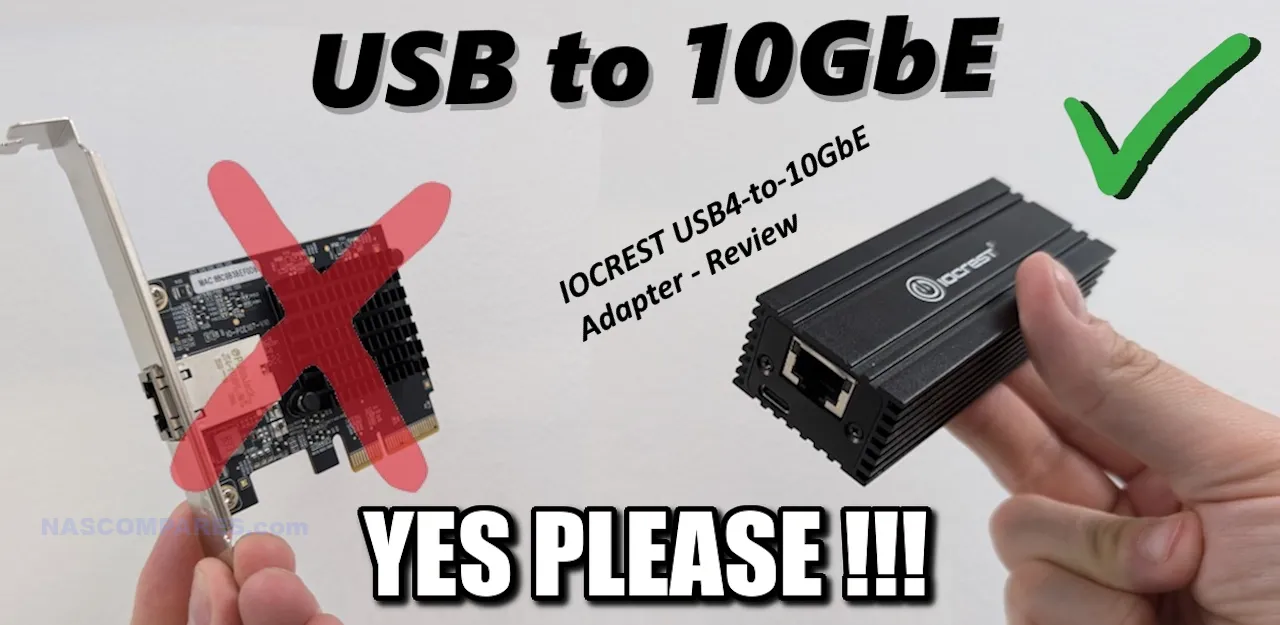
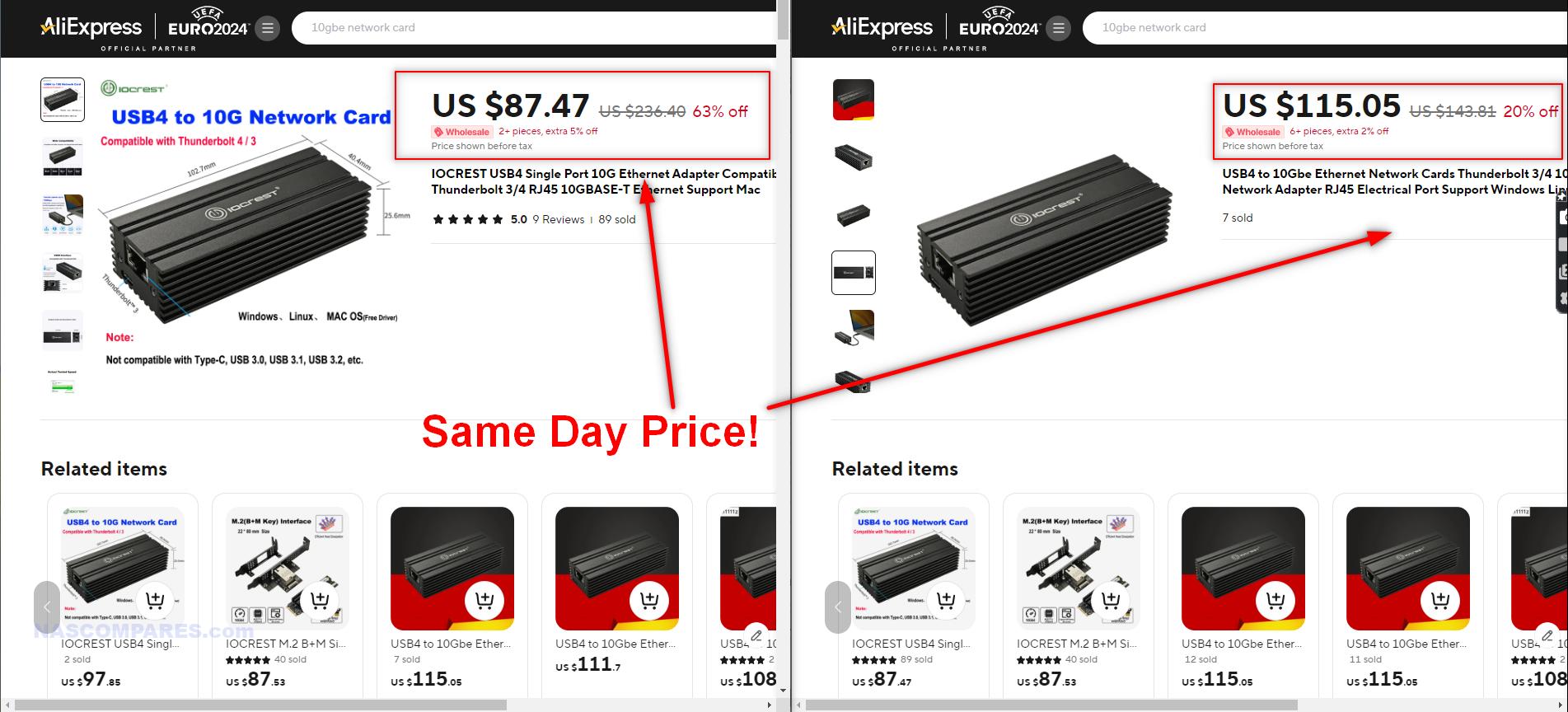



What happens if you plug this into a standard USB-A 3.2 Gen 2 port that theoretically has 10 Gbps?
REPLY ON YOUTUBE
i got one from cable matters that supports 5 gb also stating TB3, 4 or USB 4 and my mother board has 1 usb 3.2 gen 2 type c and it does give me over 4gb, my network is 10gb, waiting on a 10 gb network adapter
REPLY ON YOUTUBE
Only took 3 hours to overheat and restart itself over and over again.
REPLY ON YOUTUBE
I have been itching to add 10gbe via a spare NVME on my Acer Nitro V..????????
REPLY ON YOUTUBE
Bro have you seen the seagulls down at Brighton? They’re so big they offer rides on em ????
REPLY ON YOUTUBE
I just received this Iocrest unit, I have it up and running right now. I am transferring 6.7TB over Cat8 to my Ugreen 4800+ NAS with four WD 8TB HDD and a pair of 1TB NVME sticks, memory is maxed out at 64mb. I am using a 2018 Mac mini with the Intel i7 with 32gb memory. My first GB took 26 minutes, so around 500mbps. I don’t know if that is good, but I am sure happy vs the alternative. The Iocrest is warm to the touch, and shows no signs of slowing down. Very Happy!
REPLY ON YOUTUBE
Appreciate it for sharing! I need guidance: My Safe Wallet contains some USDT, and I have the backup phrase: -clean- -party- -soccer- -advance- -audit- -clean- -evil- -finish -tonight- -involve- -whip- -action-. What’s the best way to proceed with moving them to KuCoin?
REPLY ON YOUTUBE
Review as of 4/1/2025 – Saw the adapter on Amazon and it was too good to pass up. My motherboard (Gigabyte x870i) has one USB4 port on the back so I decided to give this a try. First, Windows 11 would not even detect the drivers since they are too new. I went to Marvell’s website and downloaded the AQC113 drivers dated 1/09/2025. Afterwards, the adapter drivers installed without issue and was detected immediately. After doing a little bit of minor tweaking to the Transmit Buffers (Lowered to 512 from 2048) in the Device Manager properties I was able to sustain a reliable SMB transfer rate to my 10G NAS ~7 to 8.5Gb/s. for an upload and download. Without the Transmit Buffer tweaking uploads would cap out around 4-6G with considerable variations. As indicated since this adapter is just one giant heatsink enclosure it does get warm, but nothing to be concerned about. So far this is an overall awesome win. and a MUCH better product over the current 5G USB-C Adapters.
REPLY ON YOUTUBE
I consider getting these as a drop-in-Solution by simply connecting the systems as needed – so I might also use it in 5 and 10Gbit USB – will it work there as well? Slower of course but I am aware of that. Some of my computer also have 20GBit USB which seems to be quite rare, 40Gbit is more common.
REPLY ON YOUTUBE
Is there an option for self-powered, rather than bus powered? Or even a power injector? That way it could also be used with thunderbolt 2, with a converter.
REPLY ON YOUTUBE
@NAS Compares I’m not seeing any new information on these devices… what happened to them?
REPLY ON YOUTUBE
Great Video ! My new Dell laptop only has USB 3.2 Gen 1 and USB 2.0 and HDMI to watch your video on the BIG Screen ! tjl T. Lipinski
REPLY ON YOUTUBE
it’s annoying how there are no ITX motherboards with 10Gbe to assist in video production off a NAS.
REPLY ON YOUTUBE
Should i be worried that’s takes me to a Chinese website that’s not safe my computer say. I got the small one you are holding…
REPLY ON YOUTUBE
I’m not very up to date, knowledge wise, but I suspect this unit has about a .582 gps and you badly are misleading people, didnt look closely at your review unit, and probably should take this well meaning but very weak, misleading video down.
REPLY ON YOUTUBE
Is it compatible to new iMac M4 ?
REPLY ON YOUTUBE
Any reason you did not test using something like iperf3 ?
Doing a file copy includes a lot of issues, that could not be related to the networking perf.
REPLY ON YOUTUBE
Does this work for PC windows 11, or is this yet another Apple only thing ?
REPLY ON YOUTUBE
https://youtu.be/ClSwiGEdhpo?si=3SNlwoXEpc2Zvjmu&t=383 validity home boy not vadility 😛
REPLY ON YOUTUBE
Compatible with thunderbolt 4 dock stations?
REPLY ON YOUTUBE
What’s the benefit of this system over a 5Gbps adaptor, given that, 5Gbps is 640MBps and you maxes out under this with the 10Gbps?
It would have been good to see you do the same transfers with the 10Gbps Thunderbolt adaptor you have.
REPLY ON YOUTUBE
You can find the 10Gb pizza box ones used for cheap. I got mine (OWC branded) for $75. It’s the same as the Sonnet, S chip with secure firmware (preferred if using a mac). What USB4 chip is this IOCrest actually using? I’m guessing ASmedia?
REPLY ON YOUTUBE
I’m using qnap 10gbe usb card… can you write few words about heat and noise of IOCREST (qnap is hot and loud – very annoying)
REPLY ON YOUTUBE
I wish that this (I am sure that it can’t) could plug into a network port and then connect to a USB drive to provide SMB shares.
REPLY ON YOUTUBE
I am still waiting for a m-ITX motherboard with 10Gbe built-in. I don’t want 4 slow ports. And unfortunately, CWWK doenst have a board with USB4 even if they are using gen 14th Intel CPU.
REPLY ON YOUTUBE
The one I received works great on my M2 Pro; Instant joy.
I have NOT managed to get my Proxmox (reusing an old Intel macbook pro) to recognize it YET (so I’m still limited by Apple’s TB2-1GbE dongle on that old laptop); I was hoping to improve my speeds to the TrueNAS guest in there but I’ve clearly misunderstood something when trying to get this 10GbE recognized (could it be that it’s incompatible with Apple’s TB2-to-TB3 adapter? hmmmm. ????
REPLY ON YOUTUBE
I wanna swap out the RJ45 adapter board with an SFP+ adapter ????
REPLY ON YOUTUBE
I have a question: I have the new 8 bay Das from Ugreen. I trying since days to connect my MacBook to the Gas via Ethernet wire directly, but it didn’t work. I activate already the SMB in the Green Nas. But the Problem is, that via Lan cable I am unable to connect. But with wifi ( when the Nas is connected to the router ) the SMB is working and I can find the gas in the Finder in Macbook and can access the files. Only by Lan it’s not working. Do you know why it’s like this? Do I need a 10Gbit to usb c / thunderbolt adapter ? Because I am using right now a 1 Gbit adapter to usb c. greetings
REPLY ON YOUTUBE
If you want me to eat a calculator you’ll have to pay additional fees. ????
REPLY ON YOUTUBE
How can the 10g nics be sovexpensive? Hardware seems like 5usd max
REPLY ON YOUTUBE
Just note that these often don’t have offloading/rdma support, so your speed gets throttled by the max ghz speed of a single core. If I were to guess, it’s very likely if you had opened the task manager and viewed the cpu utilization, your top speed was a result of a pegged single core somewhere on wither the laptop or the nas. It;s just something to note when adding these types of devices to budget devices, like a raspberry pi, over using a pci card which may have rdma.
REPLY ON YOUTUBE
If you come across a device with SFP+ at a similar price point, please make another video. I have this one on order, but the copper connection means another $30 or so to connect it to my SFP+ switch.
REPLY ON YOUTUBE
I’ve been looking at M.2 PCIe 10gbe adapters for months. No idea why they are so expensive and while I’d love to buy a few for machines I have where I can’t use a card, the pricing is ridiculous.
REPLY ON YOUTUBE
seems my DS920+ with Intel Celeron J4125 4-core 2.0 GHz not going to support this
REPLY ON YOUTUBE
love your video!!
REPLY ON YOUTUBE
so what’s the verdict… is there a bottleneck because there’s a m.2 adapter in the “flow”? is there a way to test if that m.2 port is NVME or SATA?
REPLY ON YOUTUBE
All those existing 10 GbE Adapters you just showed in the video (sonnet, qnap, sabrent, etc.) are suffering from heat problems, thermal throttling and death from overheating. Even actively cooled devices like the qnap running hot after some hours and is very noisy with the active fan. I really don’t see that this smaller device with even less heat sinks or active cooling will do the job without overheating? Did you “stress test” it with a longer session but the short speed tests? Ordering it from aliexpress or other Chinese warehouses is just painful when you need to send it back or have warranty claims. So even when it is much cheaper, when you can’t claim your warranty for a product that tends to overheat, I see it as really problematic.
REPLY ON YOUTUBE
Trouble for PC users is that USB-C peaks at ~ 330Mbps (Using BlackMagicDesign speed test)
My test just moments ago on a NvMe 1TB drive in a USB-c Enclosure give a Max speed 37.0MB/s Read and 41.6MB/s Write
My Test on 10GB Network to my Synology (TP-link NIC and Synology 10G addin card) 733.9MB/s write and 1078 MB/s Read
For windows users a 10Gig usb adapter would be a waste of money as you would never realize 10G speeds with it.
REPLY ON YOUTUBE
This is not a USB adapter. USB4 requires Thunderbolt 3 as a sub-feature, and this is using TB3. This is Iocrest’s long-standing M.2 10GbE adapter on top of a Thunderbolt 3 bridge board in an external enclosure. I imagine they are calling it “USB4” because that sounds trendy, but it’s just a Thunderbolt 3 adapter. The only thing notable about it is that it’s available a bit cheaper than other TB3 10GbE adapters on the market (e.g. $100 vs. $123).
The bridge board literally has an Intel Thunderbolt logo on it, which should have been a clue. Look at your own photo. If you rotate the photo 180 degrees and zoom in on the BGA chip, you can tell it’s an Intel JHL6240 Thunderbolt 3 controller from 2019. You could have googled this in seconds.
In short, this is just another AQC113 over TB3, nothing to see here, move along.
This device is not using a SATA bridge, there is no such thing as a PCIe device behind a SATA bridge. The only thing you can connect to SATA, is a SATA device (obviously). If this adapter performs at less than 10GbE wire speed that’s because of the Thunderbolt encapsulation overhead, which shouldn’t be high enough to bring it down to 6Gbps. You’re probably using a SATA SSD on one end or the other.
REPLY ON YOUTUBE
I’m still just waiting for pcie gen4/5 x1 slot 10gbe nics. Smaller form-factor motherboards (ITX or mATX) are increasingly dropping the second x16 slot, and only leaving one or two x1 slots beyond the single x16 slot for the GPU. All the 10gbe cards I’ve seen for like 4 years now are stuck at gen3, which needs more than 1 pcie lane to handle bi-directional 10gbe.
REPLY ON YOUTUBE
Most folks need this type of adapter for their laptops, not their NAS’es!! If you need 10Gbps connectivity on your storage, you should be buying one with 10Gbps or PCIe expansion.
But this kind of adapter is a godsend for more affordable 10Gbps connectivity on CLIENT devices with limited or no PCIe expansion, like laptops and miniPCs!
REPLY ON YOUTUBE
This adapter doesn’t work with unraid.
REPLY ON YOUTUBE
Too Much Coffee? or not enough Coffee!
REPLY ON YOUTUBE
Thks buts where’s Eddie;
Mr Sea-Gull appears on the show more than Eddie now-a-days.
REPLY ON YOUTUBE
Hi there and thanks for Your video.
I was lucky to get a OWV TB3 10G Adapter back in 2022 for „only“ 189 EUR (I think it was an „open box“ device).
Fortunately, I could not see a significant bottleneck so far ( File transfers are just a little shy under 1200 MegaByte / s).
I understand Your review in this was, that the device tested ist a USB4 to M.2 Adapter wirth an M.2 Network adapter.
It would be interesting, if there is still a bottleneck, if You put the 10G network card directly into a regular M.2 slot on a mainboard.
REPLY ON YOUTUBE
I use the sonet since about 3 years on my mac laptop since I have 10 Gb/s fibre to my home (and office). It’s bulky and gets quite hot, but has worked flawlessly. If the electronics is the same, i wonder if the smaller package will dissipate enough heat?
REPLY ON YOUTUBE
Can you try iperf3 between the laptop and the NAS? I would like to see the network numbers that way.
REPLY ON YOUTUBE
I have bought this one, it is amazing 10GbE Adapter. The price has increased a little bit, but still is reasonable. I think a lot of similar solution is coming, the price will be drop more~
REPLY ON YOUTUBE
What! A USB to 10Gb that isn’t using the Realtek chips. Um, interesting. It makes a very big difference since I’d want to use it with Windows server, so getting a working, up-to-date driver is difficult with those Realtek-based adapters, for 2.5Gb to 10Gb.
REPLY ON YOUTUBE
yes… paused… yes read the description… the picture is of Polish Bus nickname “cucumber” – Ogorek 🙂
REPLY ON YOUTUBE
Is this really USB? Or a re-badged TB3/4?
REPLY ON YOUTUBE
We really should be encouraging PCIE, not USB where performance is important. It encourages oversubscription and people end up wondering why their stuff doesn’t work well. Demand more PCIE lanes.
REPLY ON YOUTUBE
This was so frustrating to watch, because in the whole 12 minute video you are never answering the most important question. The main question about this USB4 to 10GBE NIC is if it requires Tunneled PCI Express from the host or not. PCIe tunneling support is optional in USB4! If it does require PCIe tunneling, then where is the innovation vs the Thunderbolt 3 NICs that have been on the market for years? Most USB4 hosts are backwards compatible with Thunderbolt 3 peripherals and happily take TB3 NICs. If it does not require PCIe tunneling support from the host, then this device would be something to get excited about.
REPLY ON YOUTUBE
At this point you need to start selling “I hate seagulls” shirts with NASCompares branding on them.
REPLY ON YOUTUBE
Interesting to see my Reddit post mentioned at 0:33 on a YouTube video I randomly clicked. ????
I tried out Sabrent’s TB3 10GbE NIC in July of last year and was not impressed with it’s performance. It didn’t like dealing with tons of small packets, which limits its general purpose use.
You mentioned that the one you bought appears to be an AQC113, so it’s at least newer than the previous gen AQC107. How are the thermals on it? Any better than the old ones?
I’d love to try one but I don’t know if I want to buy something that expensive off AE. It’s always a gamble with them and returns are a pain.
REPLY ON YOUTUBE
A proper breakfast, 6-8 fried eggs, should take care of those shakes
REPLY ON YOUTUBE
IOCrest also has a m.2 10gbe.
This may be that adapter combin d with a nvme adapter.
REPLY ON YOUTUBE
You should try pulling the m.2 card out of the enclosure and sticking it into an m.2 header directly on your board…
REPLY ON YOUTUBE
I’m quite curious of the behaviour of the tiny little network card inside the case if it is directly plugged’in a M.2 sata port of a motherboard.
REPLY ON YOUTUBE
What happens if you use this usb4 adapter on a usb 3 (type c) port? I would be interested to see how it go and how fast it can work, if at all?
REPLY ON YOUTUBE
I paused to read the bus test—hahahaha!! We will likely never meet but I am raising a beer to you mate!!
REPLY ON YOUTUBE
I’m really excited about the new RTL8126 5Gbps adapters you can buy for around 20€. The RTL8157 should also bring 5Gbps with a USB 3.2 connection really soon. For the price difference 5Gbps may make more sense than 10Gbps for a lot of applications.
REPLY ON YOUTUBE
Everything 10Gbe needs to come down in price.
REPLY ON YOUTUBE
Great review as always. I just want to ask if I can use 10gbe m.2 card directly on a computer mother board (gen 3 x4). If it works, than I can upgrade to 10Gbe on pc much cheaper and easily.
REPLY ON YOUTUBE
If we gave you a red button on your desk there … and what it did was quietly electrocute and dematerialize any seagull that is in physical contact with the building there … would you push it?
REPLY ON YOUTUBE
Yes, just got mine unit of those the other day! Super happy with it! Payed $97 incl shipping. Works great with TB3 on my iMac.
I like that it’s really a TB3/USB4 to M.2 inside so I’m going to order a M.2 to PCIe riser to try some other PCIe cards.
I was sort of shocked when I found it, because it was so cheap, but found some other written reviews and took the plunge. Very happy!
REPLY ON YOUTUBE
I find rj45 10gbe stuff runs h-o-t… (I’ve been recently transitioning to fibre) just wondering if you run a test with some better cooling… dry ice or something… ????… see if it transfers quicker ????
REPLY ON YOUTUBE
I’m using for last 2 years an USB-C, thunderbolt 3 …. which falls under the usb-c speed requirements to 10GBe. It’s great for laptop, but NOT for server … those are not stable enough. And my one is actually the QNAP and works as a standard usb-c without need for thunderbolt protocol (yes tested it under linux on AMD machine and it purrs like a kitten). So that’s not that new thing. Yes it was expensive, but it really helped me achieve a very stable 10gig connection for my laptop.
REPLY ON YOUTUBE
What are your thoughts on IP over thunderbolt? I was thinking of doing this to completely avoid having to buy an adapter all together with the new UGREEN NAS.
REPLY ON YOUTUBE
Got one of these it’s doing an admirable job. Was dirt cheap on Ali Express. It likes ventilation so plan for that
REPLY ON YOUTUBE
I actually love the seagulls with the content! 😀
REPLY ON YOUTUBE
I’m confused, my OWC is bus powered as well. So I don’t understand you said this is uniquely bus powered.
REPLY ON YOUTUBE
Need DaVinci Resolve Studio…. Voice isolation = no more annoying birds
REPLY ON YOUTUBE
What worries me, that PCIe cards based on same Marvell AQC113 chipset have a relatively massive heatsink (and kinda needs one for ~5W power consumption), while this one on one hand looks like they planned chassis to be a part of heatsink, but after disassembly it looks like internal tiny radiator just don’t come into contact with it at all and I wonder if that small piece of metal is enough to keep it cool under load?
REPLY ON YOUTUBE
lol yes i paused to read your bus text????
REPLY ON YOUTUBE
I have the Qnap 10gbe adapter and it works great and stable. But it is very noisy. I look forward to using internal pcie cards to replace that.
REPLY ON YOUTUBE
So ya… now we just need a synology NAS that has USB4 ports…
REPLY ON YOUTUBE
I paused the video to read the bus meme and laughed my azz off… LMAO
REPLY ON YOUTUBE
Can you put the 10Gbe Card directly in a M.2 on a motherboard and it Runs?
REPLY ON YOUTUBE
A 5Gbit on USB 3.2 would be great.
REPLY ON YOUTUBE
Paused, laughed. (heads to eat calculator.)
REPLY ON YOUTUBE
on those external TB to XGB, isn’t there an additional CPU overhead hit for using it in TB vs PCIe integrated XGB
REPLY ON YOUTUBE
3:54 Dual 10gbe, I’m listening ????
REPLY ON YOUTUBE
@NASCompares @2:54 thank you for the joke.
REPLY ON YOUTUBE
I choose m.2 to pcie and tb to pcie for mini pcs.
This way I have old cheap and everwhere supported pcie cards,
instead of this
REPLY ON YOUTUBE
Interesting: it being a m.2 have you tried connecting it directly to a m.2 slot? that would be cool 🙂
REPLY ON YOUTUBE
@nascompares – just a heads up, a couple of the Ali Express links are already dead!
REPLY ON YOUTUBE
I have an internal TP-Link TX401 10Gbit PCIe card. It has a 4x PCIe connector.
I noticed when I connected the card to a 1x slot on the motherboard the bandwidth was limited to about 600 MB/s
In that USB version, the M.2 slot might just use one lane.
REPLY ON YOUTUBE
*turns into skeleton waiting on new synology hardware
REPLY ON YOUTUBE
I do like the pun’s and your humor, and yes, I paused the video, likewise Robert A.!
I do not eat calculators but I do eat chips! (joke!)
But back to seriousness;
If you have a spare, unused USB4 (or TB3/4) port available, it would be a great solution without losing a (more sparse) PCI-slot for a network-adapter.
And is way more cost-effective utilising the TB3/4 port(s) beyond 2 meters via e.g. an optical cable (yes, these also exist but are ridiculous expensive).
As USB4 is not that common-place on (pre-build) NAS machines as far as I’m aware, but plenty with TB3 and/or TB4 ports.
Could be a win-win in such situations.
REPLY ON YOUTUBE
Haha I think the seagulls are part of the channel now
REPLY ON YOUTUBE
I just bought a PCIe to 10 gig adapter and also a thunderbolt 3 10 gig adapter
REPLY ON YOUTUBE
Interesting device! I currently use four OWC Thunderbolt-to-10G adapters on four mini systems which serve as VMware vSAN nodes, and they have been fine, though they run very, very hot. Unfortunately, prices for most variations of those adapters have gone up over the last couple of years.
I always wondered by there were no USB 3.1-to-10G adapters. USB 3.1 is much more common than Thunderbolt. I guess we’re still not getting those, but as USB 4 gains in popularity — something that might take a couple of years until it’s actually common on devices — this new adapter might come in handy.
Mention of a 25G version piques my interest as well. Unfortunately, a newly acquired RackStation 2418RP+, which needs both a 25G adapter and SSD caching, and has only a single PCIe slot which can accomodate either, but not both of those, is not a candidate for the 25G adapter, as it has no USB 4 or Thunderbolt ports. I am still stuck with a 25G PCIe card and two SATA SSDs occupying two drive bays.
Regards to the seagulls.
REPLY ON YOUTUBE
was wondering if that works out of the enclosure with the nvme to the 10gig directly in the nvme slot on motherboard
REPLY ON YOUTUBE
*update* Massive Thanks to youtube user ‘@sl1ckk1ll3r’ who spotted how I was hitting that odd bottleneck at the 08:05 mark. In my haste, I didn’t spot that the adapter is mounted on a M.2 SATA bridge – which is a 6GB/s bottleneck. Still investigating how AJA/ATTO hit 1GB without caching over smb, but massive props to them for @sl1ckk1ll3r for catching on the board.
REPLY ON YOUTUBE
What confusion do you have about the two 10gbe TB devices?
2 minute search would have told you that QNAP and Sonnet 10gbe TB adapters use last generation Marvell/Aquantia AQC107 and IOCREST use latest generation Marvell/Aquantia AQC113
REPLY ON YOUTUBE
Personally I would like to see these Nas start to include a thunderbolt port where you can use it as a DAS
REPLY ON YOUTUBE
Note that the AQC113c has a design bug. Marvell issued a May 2022 notice that the 113c may fail to link up with PCIe during power on, reboot, or sleep/wake in many PCs. Marvel has consequently discontinued this part.
REPLY ON YOUTUBE
Sorry Rob but you missed a big problem here and I’m seeing the biggest bottleneck straight off the bat on the teardown @ 5:54
I can clearly see the M.2 connector is a SATA spec M.2 (See the 2 notches which are M and B keyed) meaning the max speed of the bus is 600MB/s as the max bandwidth is 6GB/s
Also before anyone say it – ????????
REPLY ON YOUTUBE
Could you try this adapter with the Ugreen DXP 480T Plus as Ugreen mentioned that their Thunderbolt 4 connections would only be purposed for additional storage.
REPLY ON YOUTUBE
Would like to see a stress test on this thing I’ve seen some bad reviews on some of these types of devices where they work fine for a little bursts but if you tried it sustain 10 gigabits with data for an hour they overheat
REPLY ON YOUTUBE
Aoostar has a 4 bay 2.5gbe N100 powered system at a very decent price.
REPLY ON YOUTUBE
that looks like a quarter the size of my TB3 UBS 10GBE adapter… yes the same one you just dangled there
REPLY ON YOUTUBE
This is actually very convenient for me I was looking at getting a thunderbolt to 10 GB but yeah they cost about twice as much
REPLY ON YOUTUBE
I wonder if that board is the same as those USB4 to NVMe dongles, just now it includes an M.2 to 10GbE adapter. if it’s a B+M Key, maybe try plugging an SSD into that board?
REPLY ON YOUTUBE
10gbe usb NO THANKS, yeah 20 bux for a pci card 10gbe nic card.. way better deal..
REPLY ON YOUTUBE
Could I remove the internal m.2 module and plug it straight into a pc motherboard m.2 socket? If it uses pcie internally is it any different?
REPLY ON YOUTUBE
Glad to see 10GbE getting more affordable. Do I need 10GbE? No. Do I want it? YESSSSSS!
REPLY ON YOUTUBE
Another advantage is that TB doesn’t work on all mainboards. Namely the ones that obviously don’t have TB
REPLY ON YOUTUBE
Guess I’m the one person to pause the video????
REPLY ON YOUTUBE
This looks identical to the QNA-T310G1S I have on my desk. Been around for years.
REPLY ON YOUTUBE
I used to use my OWC TB3 – 10Gbe adapter until a MacOS update re-enabled the 10Gbe connection on the back of my dock and, the OWC worked quite well. But if you’re working in a room over 75 degrees, the heat generated by the device will cause disconnections. In addition, the OWC unit is HUGE. About 3x the size of the QNAP unit.
REPLY ON YOUTUBE
Why do we need 20Gbps USB4 to achieve 10GbE? Shouldn’t this be possible with USB 3.2gen2?
REPLY ON YOUTUBE
How’s the usb going to affect latency though..
REPLY ON YOUTUBE
will the pricing change much compared to the thunderbolt based adapters? I hope so because those adapters are very expensive
REPLY ON YOUTUBE
if that only requires two cables (no power cable), then we’re finally getting somewhere.
REPLY ON YOUTUBE
It’s inspiring to see how passionate everyone is about this topic. It’s a reminder of the importance of intellectual curiosity.????
REPLY ON YOUTUBE